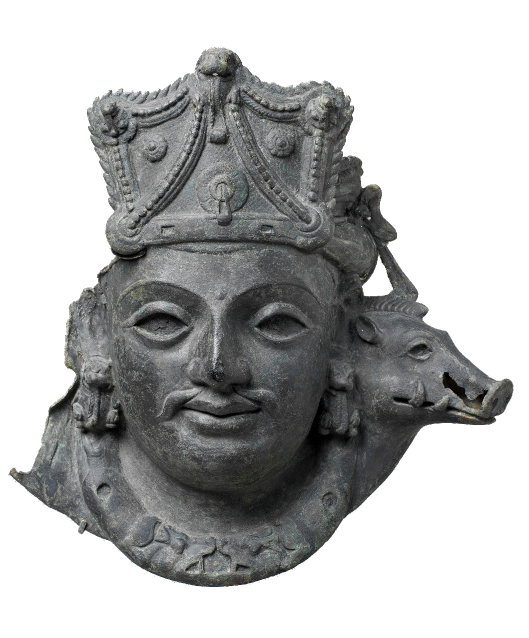PERSPECTIVES
Bringing Back the Gods: Repatriation Activism in Nepal
In June 2021, Nepal, like most of the world, was under lockdown. The roads were quiet and the days, hot and humid. “All of us were at home,” recalls Alisha Sijapati, then a journalist with the Nepali Times chasing one of the biggest stories of her life in her pyjamas. The excitement was around the discovery of five gilded bronze figurines stolen 40 years ago from a 16th century frieze over the south door of the Taleju Bhawani Temple in Mul Chowk, Patan, on the outskirts of Kathmandu. The only catch — they were about to be sold in an online auction by Bonhams, one of the world’s largest and oldest auction houses in the world.
Lost Arts of Nepal (LAN) on Facebook (now Meta) posted about the illegal sale on the afternoon of June 3 in 2021. Within a few hours, the post had gone viral.
Nepalis at home and around the world began tweeting at Bonhams, asking them to cancel the auction and return the figurines to Nepal. Sijapati was exchanging emails with LAN while getting updates on her phone from Roshan Mishra, a repatriation activist, and Sanjay Adhikari, a public interest litigator. Adhikari was in the process of filing litigation papers to stop the sale as Kanak Mani Dixit, one of the prominent media figures in Nepal, was talking to Pradeep Gyawali, the Minister of Foreign Affairs at the time.
“…The mehnat (labour), that teamwork… all of us sitting at home, constantly on the phone, being online (exchanging emails), and then the story came out!,” says Sijapati.
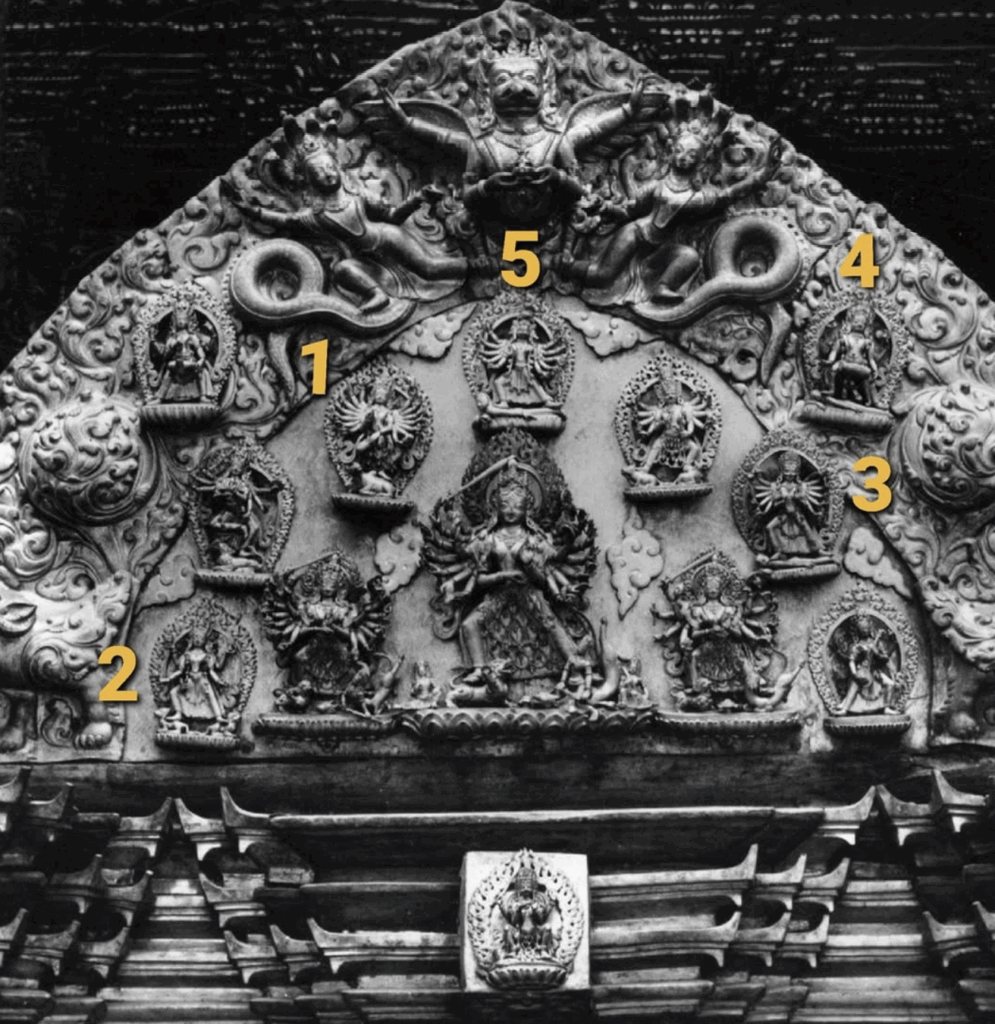
Within 24 hours of the story being published, Bonhams cancelled the auction. Bonhams also replied to every single tweet directed at them, “Thank you for your comment… These lots have already been withdrawn from the sale.”
“One, it was the power of social media, and more than just that, it was the power of solidarity and the hard work that all of us had put in,” recalls Sijapati.
Less than two weeks later, more than 7,000 miles away, Dr Sweta Gyanu Baniya’s tweet kicked off a similar campaign on June 12, 2021, “…we can only visit Nepal’s Taleju temple once a year, [but] here in Chicago, it is accessible to all…”
Though many knew that Taleju Bhawani’s necklace had disappeared from Nepal in 1976, Baniya did not know that it had been stolen; it was one of many such artifacts that had “vanished” from Nepal’s temples and shrines.
She had gone to see the breathtaking ornate gilt-copper necklace after a friend told her about the exhibit at the Art Institute of Chicago. At 10:30 pm that night, still overwhelmed, she sat down to pen an emotional blog post. She wrote, “When I first took a glance at the necklace, I started to cry, my body started to tremble, and I was overpowered with emotions. I joined my hands together and kept on bowing down to my dearest Goddess Taleju Bhawani, crying.” Her bewildered husband was unable to comprehend her emotions at first.
When she tweeted about it, she was just asking questions, wondering how the necklace had wound up displayed at the Art Institute of Chicago as one more soulless exhibit, stripped of context and meaning. Her tweet sparked a larger conversation. When she woke up the next morning, there was a storm online. Even the officials of the Ministry of Foreign Affairs, Nepal, sat up and took notice. Baniya believes that it became significant because so many Nepalis widely tweeted and shared her post.
But the spirited online repatriation campaign, the on-ground activism and heavy coverage by international publications were all for naught. Four years later, Goddess Taleju Bhawani still awaits the return of her precious necklace. Loaned from the Alsdorf Foundation by the Art Institute of Chicago in 1976, the necklace remains with the institute, though it is currently off view.
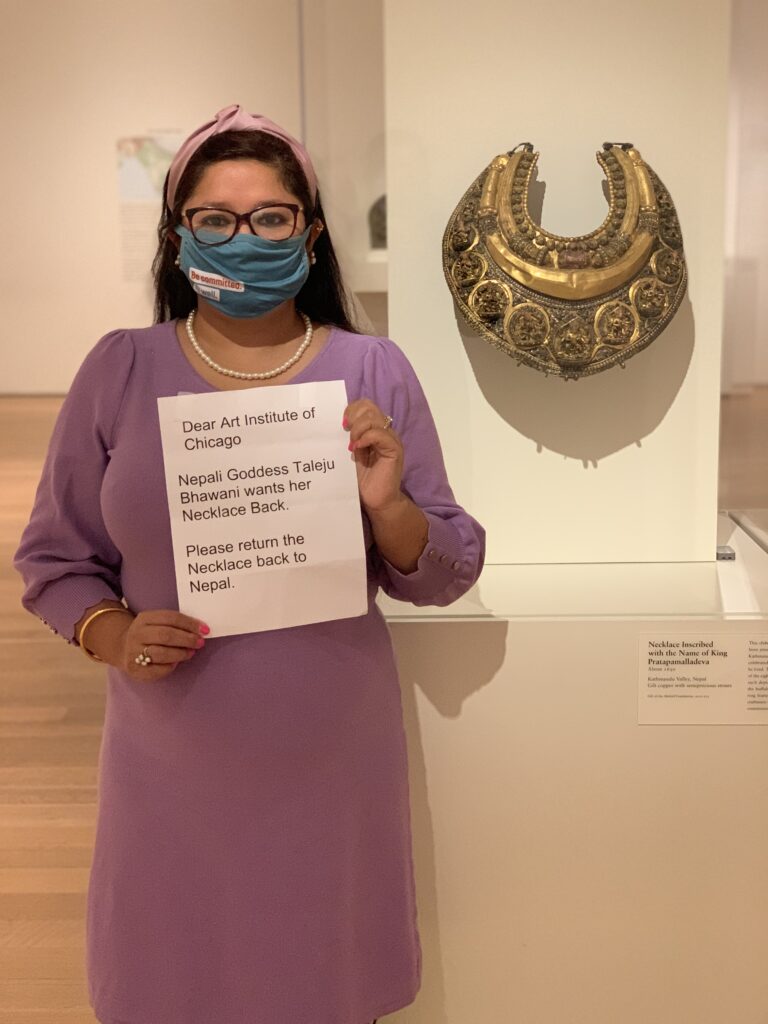
Challenges with Repatriation
A huge roadblock to repatriation of such objects is the lack of detailed documentation. Early and landmark attempts to do so were by German lawyer Jürgen Schick and art historian and artist, Lain Singh Bangdel.
Schick came to Nepal in 1980. Out of personal interest, he began his photographic documentation of the ancient art and artifacts in the Kathmandu Valley. He finally published The Gods Are Leaving Nepal in 1987, detailing around 140 cases of art theft. He also shared his photographs with Bangdel, who was one of the first Nepalis to document stolen art from the region. Bangdel’s Stolen Images of Nepal was published in 1989.
Even now, these publications are the two main sources that activists turn to when asked for “proof” that objects in foreign collections were indeed stolen from Nepal. Since then, informal documentation by travellers, and research by scholars and artists have also helped establish the groundwork for some repatriation claims.
But as the unresolved Taleju Bhawani’s necklace episode shows, even when stolen objects are identified, repatriation is not a given outcome.
Once-colonised nations are accustomed to seeing their looted national treasures being auctioned off or put up as “aesthetic” art objects in Western museums. But Nepal is a unique case. It remained largely closed to foreigners until the 1950s. But when visitors started arriving, idols started disappearing from shrines, wrenched from the communities that had worshipped them for centuries.
What began as looting by outsiders, continued to be perpetrated by locals who smuggled artifacts, paintings, even carved architectural elements, to make a living by supplying to the global black market of stolen art and antiques — a market where they were the lowest and least paid rung and also the most liable to face criminal charges.
During Nepal’s decade-long civil war (1996-2006), heritage took a backseat as protecting human rights became the priority. This further emboldened thieves who used the country’s upheaval to blithely loot and smuggle out objects of significant cultural value. Sijapati chooses her words carefully when she describes, in the context of Nepal, the acts as “stealing” and not “looting.” As she sees it, looting is indiscriminate, unfair, and unjust, such as pillaging during the wars in Africa or Cambodia or how colonisers systematically stripped their colonies of valuables. But Nepal’s gods? They were consciously “stolen.”
“We are the victims as well as the enablers,” she rues.
In 2025, countless such sacred objects, stolen from Nepal, still lie scattered in collections, both public and private, around the world.
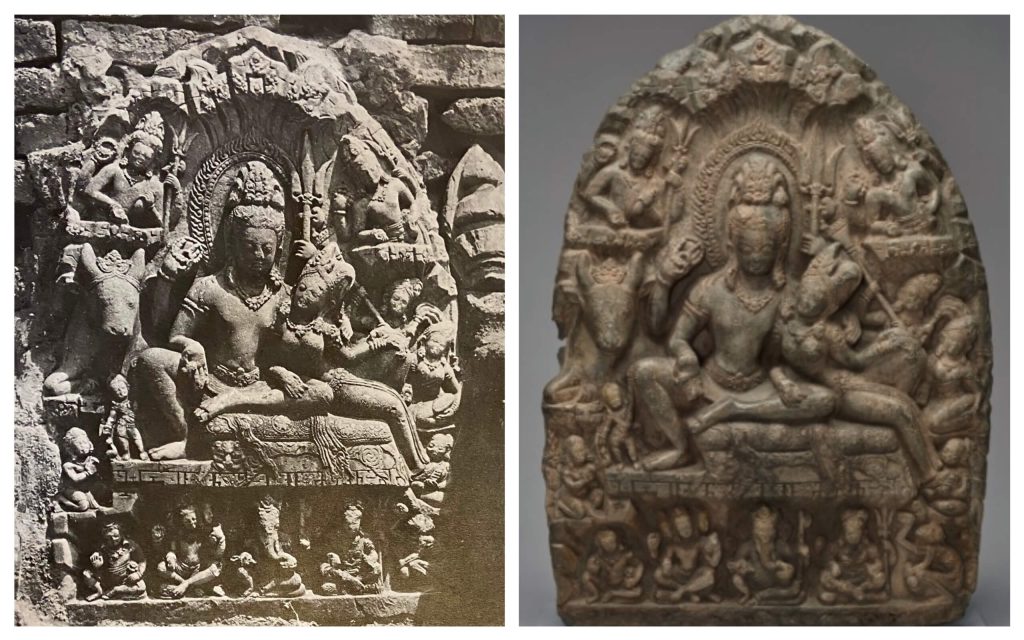
The Legal Angle
The international treaty, part of the UNESCO 1970 Convention, makes the theft, looting and illicit trafficking of member nations’ cultural property a crime. Adhikari says that Nepal ratified this treaty in 1976, and its Ancient Monuments Preservation Act, 1956, also makes it clear that no “cultural property” can be exported outside the country. In the case of Nepal, an export license is only applicable to curios, not heritage objects, especially those over 100 years old. Legally, all the stolen gods and goddesses are still defined as “archaeological” objects, rather than “cultural” ones.
Adhikari laments that Nepal still lacks a legal definition of what can be called “cultural property.” Activists in Nepal are trying to rectify this so that they can use provisions from the UNESCO treaty and national laws in repatriation claims. But, for a country as diverse as Nepal, it will always be a challenge to define what is and what is not “culturally significant.”
Mishra suggests that the Nepal government must make its laws simple and clear to international institutions and collectors. Then, any and all cultural objects added to collections after 1956 will automatically be considered “stolen,” and this would strengthen repatriation bids and also end their illegal trade.
On June 15, 2025, at the International Conference on Recovery of Cultural Heritage in Patan, Bradley Gordon, legal advisor to Cambodia’s Ministry of Culture, suggested Nepal could adopt another course of action that has proved successful — putting the onus on the institutions selling or exhibiting stolen cultural objects.
Gordon has been instrumental in recovering several treasures, stolen between the 1960s to the 1990s, after he began telling museums to prove they had the “right to possess” such pilfered treasures, instead of Cambodia having to prove its claims. Activists around the world, not just in South Asia, are coming to the realisation that the burden of proving that an object was stolen should not fall on the countries they were stolen from.
The trade in stolen cultural objects is extremely profitable. There is no impetus to stop until the head of the snake — in terms of demand from collectors and institutions — is cut off.
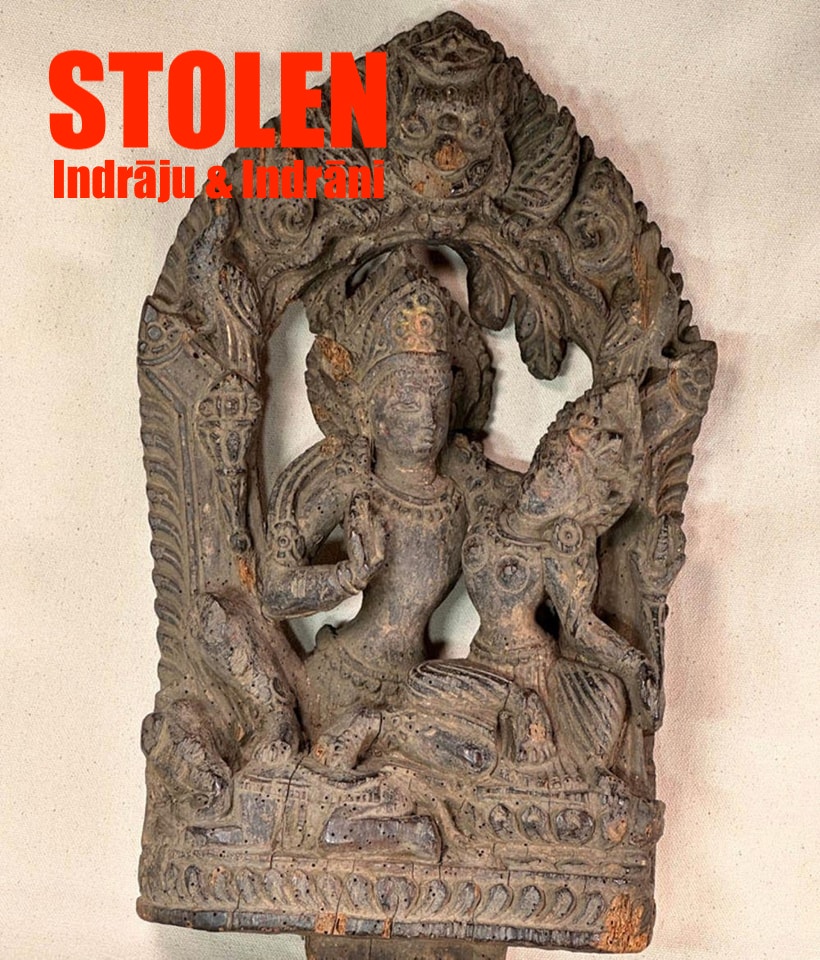
Lucrative deal-making in less savoury contexts, fueled by this demand, has meant that activists documenting Nepal’s lost heritage often face death threats or have been asked to leave the country if they are non-residents. Schick recollects how his visa was cancelled and he had to leave Nepal with his family. He was able to return only years later to continue his work. Bibhakar Shakya, Bangdel’s son-in-law, recalls how Bangdel received several death threats while writing Stolen Images of Nepal (1989).
In contrast, those who get caught smuggling artifacts out of the country face little to no jail time. For instance, after a 2018 Al Jazeera sting operation that led to arrests, the criminals weren’t behind bars even for a month. “We are risking our lives and they are coming out in two weeks,” says Rabindra Puri, a conservationist and a sculptor. Puri depends on his accumulated goodwill among communities, having worked with them for over 25 years in heritage conservation, to stay safe as he pushes for people-led, grassroots campaigning to demand the return of local deities.
Repatriation activists in Nepal are painfully aware of the risks they face. LAN, for instance, is an entirely anonymous enterprise that runs via their much-visited Facebook page. All their direct communication with individuals and organisations is via an email account or on Facebook Messenger only. Their stealth mode of operation is most likely to ward off threats though they refuse to comment on this aspect when asked about it.
There are no laws in Nepal protecting whistle blowers, and activists know that they could be targeted by those who benefit from the illegal trade in stolen cultural artifacts — from local criminal networks to people who wield political and bureaucratic power for personal gain.
“I believe the only protection we get is from the divine,” says Adhikari.
What Lies Ahead
In an email interview, LAN says an increasing number of objects have been identified in foreign collections — so many in fact that they have stopped keeping track of the exact numbers now. Over the years, they have been instrumental in creating the crucial chain of documented evidence to verify the provenance of stolen antiquities.
Only 197 artifacts have been repatriated in total, according to Nepal’s Department of Archaeology. Forty of those 197 objects were returned based on information provided by LAN.
But a significant majority of the identified objects still languish abroad while several others are yet to be identified and located. Adhikari stresses that while the documentation of existing cultural heritage is necessary, recovering stolen cultural properties has to be the main priority. His concern is that once an older generation of Nepalis dies out, it may be impossible to determine a repatriated object’s exact place of origin, making it difficult to return these objects to their communities.
In 2003, Puri conceived the idea of a Museum of Stolen Arts (to be opened in 2026), to showcase replicas as a way to increase awareness in younger generations about what they have lost. Ultimately, he hopes that international museums and collectors will return the stolen gods and purchase the replicas instead. Mishra says that the replicas could be an opportunity for museums to tell a brand-new story around them — one that would be far more interesting to visitors — the story of the gods coming home to their communities, supported by video and art showcasing these reunions.
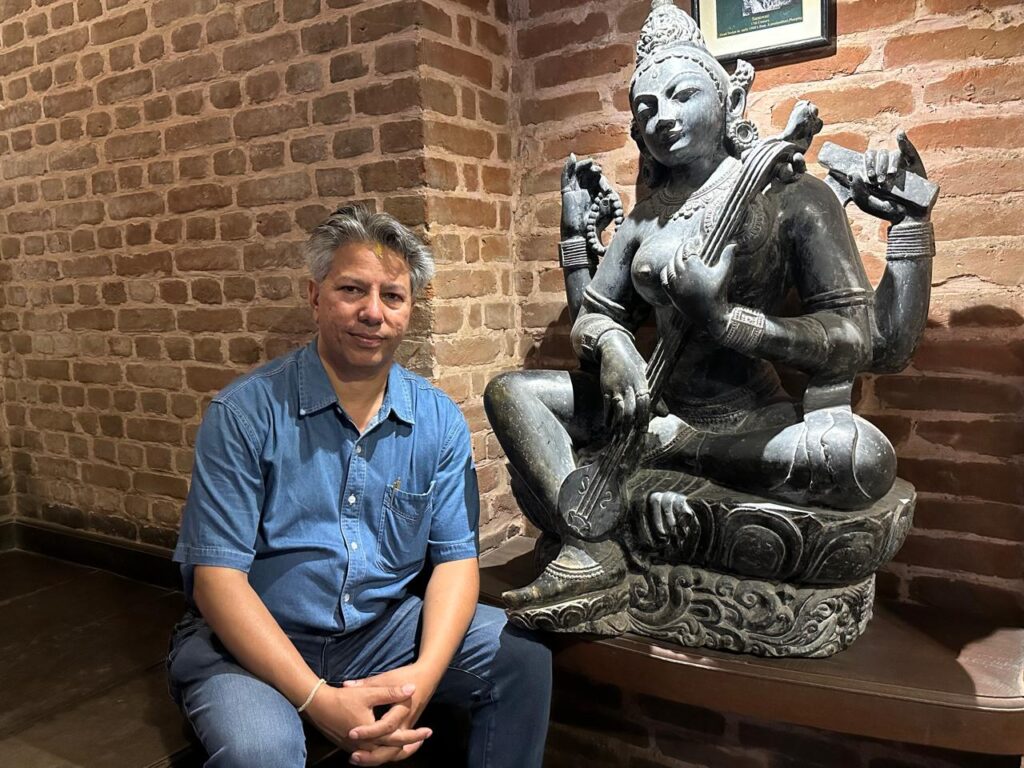
Sijapati and LAN think that the instances where statues have been returned to the very temples and communities they were stolen from, is the best kind of victory. Much better than them collecting dust in some Nepali museum after being repatriated. A community’s renewed sense of ownership and traditions has always been the end goal in repatriation campaigns emerging from Nepal.
Activists say the US has been more cooperative in sending back stolen art than countries in West Europe; it has also been easier to get back objects from private art collections than large museums, which tend to be funded by taxpayers.
“Orphan objects” are those that are not ethically sourced or lack provenance and such objects hold little to no value. Mishra believes this makes a strong case for such objects to be sent back to the countries they came from. While stolen objects are coming back to Nepal in a slow trickle, criminalising large museums for possessing such objects is still a difficult task due to existing laws and the clout wielded, internationally, by these institutions.
“If you stop the demand, the supply will dry out,” says archaeologist and professor, Dr Amr Al-Azm, “It is the supply side that is the victim.”
Tangible Deities, Intangible Culture
Every single day in Nepal is a celebration of life. This is all the more apparent in the temples and shrines dotting its landscapes where rituals of daily living blend with the worship of the local deities. In the nation’s countless jatras (religious processions), the gods and goddesses are beloved members of the community. People not only worship them but sing, dance and feast with them as part of familial and community celebrations. Rituals involving sacred objects, some seasonal and some daily, constitute a form of cultural production too, making “tangible” gods and goddesses a part of “intangible” living culture. When the gods are stolen, the culture tied to them disappears too.
Filmmaker Amitabh Joshi, who made the poignant documentary Have You Seen My Gods?, talks about the practice of pregnant women dropping oil over the head of the androgynous Laxmi-Narayan, a statue that represents Narayan (Vishnu) on the right and Laxmi on the left. If the oil dripped on the male side, the family would expect a baby boy. If the oil rolled down the female side, the birth of a girl was predicted. When the statue was stolen, this practice also disappeared.
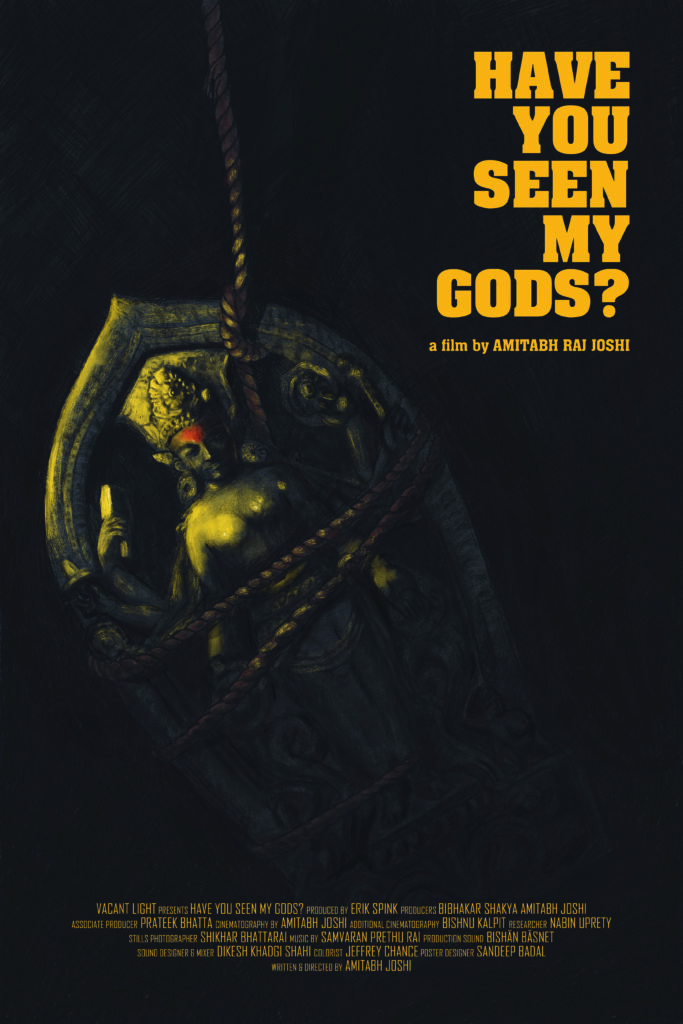
This is why Mishra, who also runs the Global Nepali Museum, remembers feeling shocked when the Art Institute of Chicago asked why Nepal was claiming the Taleju Bhawani’s necklace “after all these years.”
“That question itself was very irrelevant,” he says.
Given the intransigence from most institutions while responding to legitimate campaigning for the return of stolen objects, the year 2021 is seen as a miracle year by Nepal’s cultural activists — one that gave the repatriation movement in the country a new lease of life. Close on the heels of the momentous events of the June 2021 Bonhams auction, the thousand-year-old Laxmi-Narayan statue stolen from Patko Tole in 1984 was reinstated in December 2021 with a traditional jatra.
Dixit says that the return of Laxmi-Narayan galvanised everyone to come together to form an organisation dedicated to the repatriation of stolen objects — the Nepal Heritage Recovery Campaign (NHRC). The team also includes Mishra, Sijapati, Adhikari, and Puri. Lost Arts of Nepal (LAN) is among NHRC’s advisors too.
In their email interview, LAN says that though they started their Facebook page right after the 2015 earthquake, 10 years ago, the empty spaces left behind after repeated thefts had been haunting Nepal much before that. Questions were being asked but no answers were forthcoming. NHRC is a step toward getting those answers, leveraging each members’ expertise and domain knowledge.
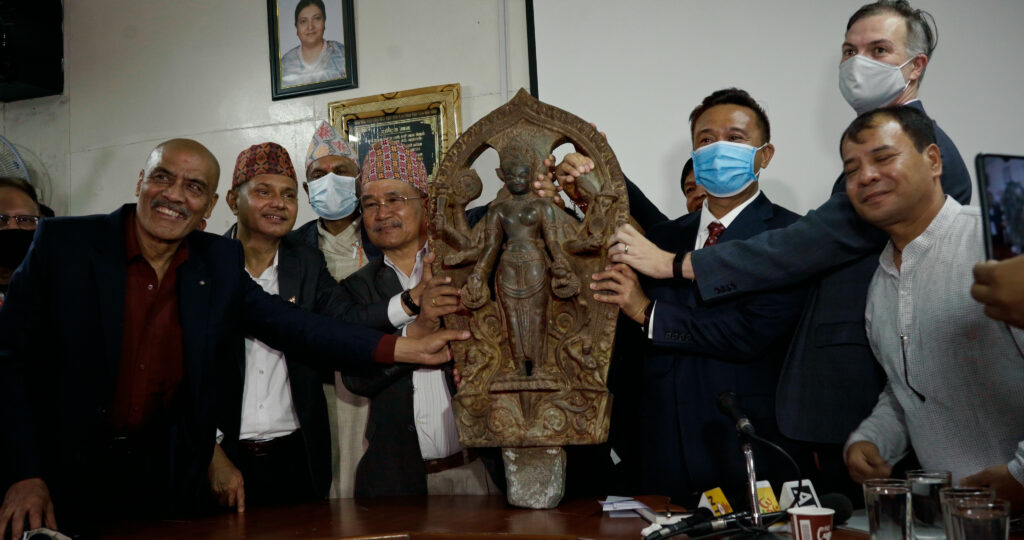
Culture Interrupted
Activist cultural production has been lock-step for many years in highlighting the disruption of culture because of the thefts, such as the series of photo-realistic paintings by artist and researcher Joy Lynn Davis. In them, she “visually repatriates” stolen sculptures back to their original sites, painting them into photographs using 23 karat gold paint. The use of gold underlines the commodification of the sacred, standing-in for both divinity and the ill-gotten wealth from illegal sales. Each painting is accompanied by interviews documenting the community responses to the thefts. In 2013, the project received funding from UNESCO and has, since then, been part of several community outreach efforts and exhibitions, in Nepal and the US.
Similarly, Joshi is holding screenings of his documentary, which premiered in May 2025 in Kathmandu, the site of many thefts. Tugging at the heartstrings, the film opens with an old home video from 1991, where a little boy (Joshi as a child) says “bye” to his gods; he grows up hearing his grandmother talk about the “missing gods” and she attributes her failing health to their loss.
Baniya believes that linking thefts to the loss felt by communities, to the loss of living traditions, is the key. Encouraged by her viral tweet moment, she makes sure to talk about stolen objects in this context. As a part of the Nepali diaspora in the US, both Joshi and Baniya believe that these conversations are important. The right kind of attention on Nepal, usually exoticised in foreign media as the “land of the Himalayas” and not much else, can generate the international pressure required to boost the success rate of repatriation campaigns.
Dixit says that Nepal is lucky to not have to resort to anti-colonial diatribes while demanding the return of stolen objects, adding that “national pride” is not what propels campaigns from Nepal. “National pride can work as a tactic sometimes… but us campaigners, we believe in the faith, in the living culture of Nepal.”
Sarita Ramamoorthy is a researcher, editor, and writer based in Kathmandu. She has a master’s in Asia Pacific Studies from the Australian National University, Canberra and a diploma in Indian Aesthetics from Jnanapravaha, Mumbai.
